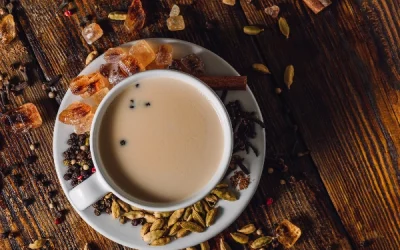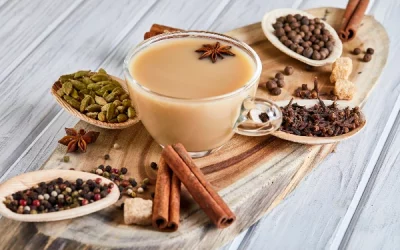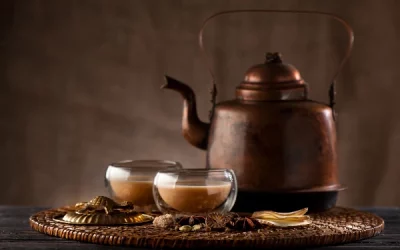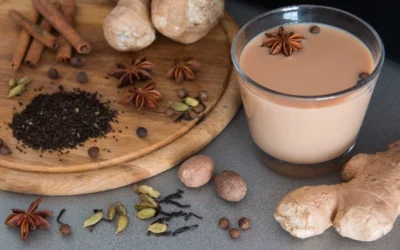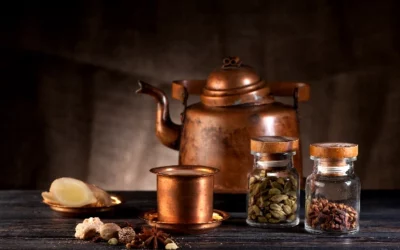Ever wondered why some teas turn a stunning shade of pink? Pink tea, or Kashmiri Chai, is not just a delightful beverage; it carries deep cultural significance and an elaborate preparation ritual that has enchanted many. This guide will unravel the origins, preparation methods, and essential ingredients that make pink tea so special. Whether you’re a cooking enthusiast or a cultural food lover, mastering this aromatic drink will elevate your culinary repertoire. Let’s dive into the world of Kashmiri Chai and create authentic pink tea at home!
Table of Content
- What is pink tea and its cultural significance?
- How do you prepare authentic pink tea at home?
- What ingredients are essential for making pink tea?
- Why does pink tea have its unique colour?
- What are common mistakes to avoid when making pink tea?
- How can I enhance the flavour of pink tea?
- Where can I find the best ingredients for making pink tea?
- How can I store leftover pink tea?
- Conclusion
What is pink tea and its cultural significance?
Pink tea, also known as Kashmiri Chai, is a unique beverage with deep roots in the culture and history of Kashmir, a picturesque region nestled in the Indian subcontinent. This distinctive tea is celebrated for its beautiful pink hue and rich, creamy texture. Beyond its delightful taste, pink tea carries significant cultural weight in South Asian traditions, especially in Kashmir. It embodies a sense of community, hospitality, and celebration.
Pink tea’s historical roots trace back to the Himalayas, where it evolved as a warming drink in the cold climate. Over time, it became a staple in Kashmiri households and a symbol of their rich culinary heritage. Pink tea is traditionally served during special occasions like weddings, festivals, and family gatherings, making it an integral part of the festivities.
The process of making pink tea itself is a cherished ritual, often involving the whole family. Variations of pink tea exist in different cultures, each adding its unique twist to the traditional recipe.
While the Kashmiri version is the most famous, you can find similar beverages in regions like Afghanistan and parts of Central Asia.
What are the historical origins of pink tea?
The historical origins of pink tea date back centuries, rooted in the cold mountainous regions of Kashmir. It was created to provide warmth and comfort during harsh winters. Over time, this beverage evolved into a cultural icon, representing the essence of Kashmiri hospitality and tradition.
- Pink tea, or Noon Chai, has its name from the local word “noon,” meaning salt, a key ingredient in the traditional recipe.
- The tea’s pink color comes from a special preparation process involving baking soda and a long brewing time.
- Pink tea has been enjoyed by Kashmiri people for centuries and has spread to neighbouring regions.
- It is a symbol of community and togetherness, often enjoyed in large gatherings.
- Historical records suggest that pink tea was served to royal guests and dignitaries, emphasising its cultural importance.
Pink tea’s traditional preparation uses green tea leaves, milk, salt, and baking soda. The unique brewing process creates its distinctive pink color, which sets it apart from other teas. This beverage has a deep connection to Kashmiri culture, where it is more than just a drink; it’s a symbol of warmth and hospitality.
How is pink tea traditionally served during special occasions?
Pink tea holds a special place in Kashmiri traditions, often being the highlight of special occasions and celebrations. Whether it’s a wedding, festival, or family gathering, pink tea is an essential part of the menu, served with love and care.
- Pink tea is typically served in small, ornate cups or bowls, showcasing its beautiful colour.
- During weddings, it’s a customary drink, often served with traditional Kashmiri bread like “baqerkhani.”
- Festivals such as Eid and Navroz see families coming together to prepare and enjoy pink tea.
- In winter, it is enjoyed with a variety of local snacks and sweets, making it a comfort drink.
- The preparation and serving of pink tea are considered an art form, passed down through generations.
The traditional method of serving pink tea involves a lot of care and attention. Each step, from brewing to serving, is done with precision, ensuring the perfect taste and appearance.
The tea is usually accompanied by local delicacies, enhancing the overall experience. Sharing pink tea with guests is a way of expressing hospitality and warmth, making them feel part of the family.
What variations of pink tea exist in different cultures?
While Kashmiri Chai is the most well-known version, variations of pink tea can be found in different cultures, each bringing its unique twist to the traditional recipe. These variations highlight the adaptability and widespread appeal of this delightful beverage.
- Afghan Chai: Similar to Kashmiri Chai but often sweeter and sometimes flavoured with cardamom or rose petals.
- Central Asian Variants: In regions like Uzbekistan, pink tea may include ingredients like cloves and cinnamon.
- Pakistani Version: Often similar to the Kashmiri version but with more sugar and less salt.
- Middle Eastern Twist: Some Middle Eastern cultures have adopted pink tea, adding their spices like saffron or nutmeg.
- Western Adaptations: In recent years, pink tea has gained popularity worldwide, with variations including vegan versions and different flavour infusions.
These variations showcase the versatility of pink tea, allowing it to be adapted to different tastes and preferences. Each culture brings its unique ingredients and methods, creating exciting new versions of this traditional drink. Despite the differences, the essence of pink tea remains the same – a delightful beverage enjoyed with loved ones.
The history of pink tea is rich and fascinating. One notable story is about the famous Mughal emperor Akbar, who, during his visit to Kashmir, was served pink tea by local villagers.
Impressed by its unique taste and the warmth of the people, he introduced it to his court, where it became a favourite among the nobles. This royal endorsement helped spread the popularity of pink tea beyond Kashmir, making it a beloved beverage in many parts of India.
How do you prepare authentic pink tea at home?
To prepare authentic pink tea at home, you’ll need a few unique ingredients and a bit of patience. This delightful beverage, also known as Kashmiri chai, boasts a lovely pink hue and a rich, creamy flavour. Follow the detailed steps below to create this beautiful tea.
The process of making pink tea involves several stages, from boiling tea leaves to adding milk and spices. Understanding the steps and ingredients is key to achieving that perfect pink colour and taste. Here’s a comprehensive table to guide you through the preparation:
| Ingredients | Quantities | Preparation Steps |
|---|---|---|
| Green tea leaves | 2 tablespoons | Boil with water until the colour changes to a deep red. |
| Water | 4 cups | Use for boiling tea leaves and creating the ‘kahwa’. |
| Cardamom pods | 4-5 pods | Crush and add to the boiling tea for flavour. |
| Baking soda | 1/4 teaspoon | Add to the boiling tea to help achieve the pink colour. |
| Cold water | 1/2 cup | Add to the mixture and vigorously whisk to create froth. |
| Milk | 2 cups | Gradually add to the tea mixture while stirring. |
| Sugar | To taste | Add to sweeten the tea according to your preference. |
| Crushed almonds/pistachios | For garnish | Sprinkle on top of the tea before serving. |
Step-by-Step Guide:
- Boil green tea leaves with water until the colour turns deep red.
- Crush cardamom pods and add them to the boiling tea for a fragrant aroma.
- Add baking soda to help develop the pink colour as the tea boils.
- Pour in cold water and whisk the mixture energetically to create a frothy texture.
- Gradually add milk while stirring continuously to develop the rich, creamy consistency.
- Sweeten with sugar according to taste.
- Garnish with crushed almonds or pistachios before serving.
What are the key ingredients for authentic pink tea?
When making pink tea, the ingredients you choose play a significant role in the final taste and appearance. Here’s a deeper look into each key ingredient and why they’re essential:
- Green Tea Leaves: The base of pink tea, these leaves provide a unique flavour and are crucial for the tea’s colour transformation.
- Cardamom Pods: These pods add a distinct, aromatic touch to the tea.
- Baking Soda: A small amount of baking soda helps achieve the characteristic pink colour.
- Cold Water: This is used to froth the tea during preparation, enhancing its texture.
- Milk: Adds creaminess and balances the strong flavours.
- Sugar: Sweetens the tea to taste.
- Crushed Almonds/Pistachios: These add a decorative and flavourful garnish.
How long does it take to make pink tea?
Making pink tea is a bit of a time investment, but it’s worth every minute. Here’s a breakdown of the time you’ll need:
- Preparation Time: 10 minutes
- Boiling Time: 30-40 minutes
- Whisking and Frothing: 5-10 minutes
- Final Preparation and Serving: 5 minutes
Steps to keep in mind:
- Boiling the tea leaves to the right colour is crucial and takes the most time.
- Whisking the tea mixture after adding cold water helps create a frothy texture.
- Gradually adding milk and ensuring continuous stirring helps achieve the perfect consistency.
Creating pink tea might take some patience, but it’s a rewarding process. You’ll end up with a beautiful and delicious cup of tea.
During the 16th century in the lush valleys of Kashmir, a tea master named Zain-ul-Abidin innovated the local tea preparation technique by introducing the use of unique green tea leaves and an intricate boiling process. This method resulted in the beautiful pink hue that we associate with Kashmiri chai today. The tradition has endured through centuries, with each generation adding its touch to this cultural beverage.
When I first attempted to make pink tea at home, I was quite sceptical. The process seemed long and complicated. However, as I boiled the tea leaves and watched them transform into a deep red, I got excited.
Adding the cold water and whisking vigorously was surprisingly fun. As the milk blended in and the tea turned pink, I felt a sense of accomplishment. The first sip was delightful, the perfect combination of creamy and fragrant. Now, making pink tea is a favourite weekend ritual.
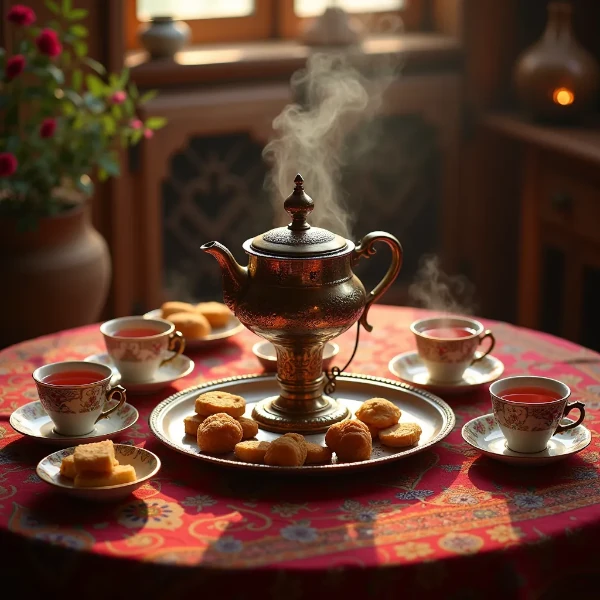
What ingredients are essential for making pink tea?
Alright, folks, let’s dive into the magical, frothy world of pink tea, also known as Kashmiri chai. It’s not just any cup of tea; it’s a delightful concoction that brings together a bouquet of ingredients to produce its unique flavour and rosy hue. Here’s your one-way ticket to understanding the essential components you need in your kitchen to whip up this glorious drink.
The star of the show is Kashmiri tea leaves. These leaves are the soul of pink tea, infusing it with a distinctive taste that’s both earthy and slightly floral. We then add a pinch of baking soda – yes, you heard that right.
Baking soda helps in oxidising the tea leaves, contributing to both the colour and that rich, creamy texture we all love. Next on the list is milk, where the debate often rages about which type to use.
Whole milk is your go-to for an authentic, creamy experience. Want to add an exotic twist? Toss in some cardamom and cinnamon for that aromatic punch. Finally, let’s not forget sweeteners – from sugar to honey, each brings its own flair to the final taste.
Yes, it’s a bit of alchemy, mixing these ingredients just right to get that perfect cup. But when you do, you’ll find it’s worth every bit of effort.
Can I substitute Kashmiri tea leaves with other types of tea?
Oh, you adventurous soul, always looking to bend the rules! While the short answer is yes, the long answer is a bit more nuanced.
- If you’re thinking of swapping Kashmiri tea leaves with green tea, you might get close, but don’t expect a perfect clone. The flavour profile will be off.
- Black tea is also another option, but it will lack that subtlety and complexity. The colour won’t quite hit that magical pink either.
- Some radicals even use oolong tea – though it introduces an entirely different taste, which might be fantastic…or a bit of a risk.
- You could mix and match multiple teas, though tread carefully and don’t tip the balance too far from the original intent.
But really, if you want the true Kashmiri chai experience, better to stick to the authentic leaves. They’re the real MVPs here, giving that signature taste and colour you crave.
What are the best types of milk to use for pink tea?
Now, let’s get milky, shall we? The type of milk you use can make or break your pink tea experience.
- Whole milk is the traditional favourite, thanks to its creamy consistency.
- Evaporated milk can add an extra layer of richness and depth.
- Plant-based options like almond milk or coconut milk are worth exploring for a dairy-free twist.
- Condensed milk can double up as a sweetener, turning your tea into a decadent treat.
- Skimmed milk, though not as creamy, can be a lighter alternative if you’re counting calories.
Experiment with these to see which one tickles your taste buds the most. Remember, the creamier, the better for achieving that luxurious texture.
How do different sweeteners affect the taste of pink tea?
Alright, the cherry on top – sweeteners. They can dramatically change the personality of your pink tea.
- Plain sugar is the classic and most straightforward choice. It sweetens without altering the fundamental taste.
- Honey, adding a floral and sometimes fruity nuance, can make your tea taste exotic.
- Brown sugar gives a caramel-like flavour, adding more depth.
- Stevia offers calorie-conscious sweetness but might introduce a slightly bitter aftertaste.
- Jaggery or palm sugar, commonly used in traditional recipes, give a slightly earthy and intense sweetness.
Each type of sweetener you pick will influence the final taste, so choose wisely depending on whether you want traditional notes or a modern twist.
Making pink tea isn’t just a recipe; it’s an experience. Speaking of experiences, did you know the tradition of Kashmiri tea dates back to ancient Persian influences brought to the Indian subcontinent by various travellers and rulers?
The Mughal Empire, teeming with rich culinary traditions and a penchant for luxury, played a significant role in popularising this delightful tea. They didn’t just drink tea; they turned it into an art form, mixing spices and sweeteners to create the perfect brew.
It’s fascinating how a centuries-old practice still brings people together in kitchens around the world today.
Why does pink tea have its unique colour?
Ever wondered why pink tea is, well, pink? Spoiler alert: it’s not magic, though it may seem like a bit of a kitchen wizardry. Let’s dive into the nitty-gritty science behind this pretty hue.
First off, pink tea owes its vibrant colour to a fine mix of chemistry and technique. If you’re thinking it’s just about throwing in some food colouring, think again. The authentic pink shade is the result of:
- Baking soda: This little ingredient has a critical role.
- Aeration process: Plenty of frothing and whisking.
- Temperature shocks: Introducing the tea to alternating hot and cold environments.
- Chemical reactions: Various components reacting together to produce that distinct colour.
The combination of these factors is what makes the colour transformation happen. But let’s dig deeper into each element.
What is the role of baking soda in achieving the pink colour?
Baking soda isn’t just for baking cakes; it’s got a starring role in pink tea. Adding this to your tea changes the pH levels, influencing the colour by fostering a chemical reaction between the tea’s natural tannins and other compounds.
- pH level alteration: Baking soda makes the tea less acidic.
- Enhanced colour reaction: It boosts the conversion from brown to pink.
- Texture and taste improvement: Yes, it even smooths out the flavour.
- Chemical catalyst: Acts as a promoter for other reactions.
You might think baking soda is just an add-in to achieve colour, but it also improves the overall tea experience— smoother, creamier, and definitely prettier.
How does temperature affect the colour of the tea?
Temperature shocks sound like something from a sci-fi movie, but in pink tea making, they’re all about achieving that perfect hue. Fluctuating temperatures cause the tea compounds to undergo changes, which then reflect as that lovely pink shade.
- Rapid cooling: Helps lock in the colour.
- Hot and cold alternation: Enhances the intensity.
- Maintains flavour: Prevents the tea from becoming too bitter.
- Encourages froth: Aeration happens better at varied temperatures.
So, giving your tea a quick icy dunk after brewing isn’t just fun to watch—it’s key to its rosy radiance.
Can the pink colour be achieved without baking soda?
You might be wondering if it’s possible to get that pink glow without raiding your baking supplies. The short answer is—yes, but it’s a bit of a gamble.
- Other alkaline agents: You could use alternatives like lime or potassium carbonate.
- Risk of dullness: Colours might not be as vibrant.
- Longer process: Can take more time to achieve.
- Natural acids impact: Won’t neutralise the acids as effectively.
The key factor is that baking soda provides a dependable, consistent result. Alternatives might get you there, but with a bit more trial and error.
Believe it or not, the fascination with the vibrant colours of tea isn’t new. During the Mughal era in India, special attention was given to the aesthetics of food and drink. One popular beverage included a precursor to what we know now as pink tea.
Travellers and traders would discuss its unique colour and attributes in the bustling marketplaces from Lahore to Samarkand. It’s fascinating how the same mix of chemistry and appreciate for beauty has been enchanting us for centuries.
So next time you’re sipping on your pink tea, remember you’re tasting a bit of history and a lot of science!
What are common mistakes to avoid when making pink tea?
Preparing pink tea, also known as Kashmiri chai, can be a delightful experience or a frustrating one, depending on how you go about it. This beautiful drink with its rosy hue is not that challenging to make, but there are some classic pitfalls you should sidestep to avoid ending up with a murky mess instead of a vibrant libation. Let’s dive into some of the common mistakes people make while brewing this eye-pleasing beverage.
Incorrect ingredient proportions
When it comes to making pink tea, balance is everything. Think of it as putting together the perfect outfit – too much of one thing, and it throws the whole look off.
- Too much baking soda: This can turn your tea into a bubbling science experiment and messes up the flavour big time.
- Too little or too much tea leaves: Adds bitterness if overdone, or leaves your tea looking like coloured water if underdone.
- Misjudging milk quantity: Too much milk drowns out the floral and earthy notes, not enough, and it loses its creaminess.
So, next time you whip up a batch, think Goldilocks – get that just right proportion.
Improper brewing techniques
Brewing pink tea isn’t just about dumping leaves into a pot and waiting. It’s a bit more like conducting a symphony.
- Inconsistent heat: Changing temperatures can make the tea leaves throw a tantrum, giving you an uneven taste.
- Skipping the cold water step: Essential for the final flavour profile and colour.
- Rushing the process: Hurrying leads to disaster; patience is your friend.
Think of your pot as a stage and your tea leaves as the star performers needing the right conditions to shine.
Failure to aerate the tea
Aeration is one of those steps that seems optional until you skip it and ruin everything. Properly whisking or pouring the tea back and forth between two containers is crucial for that pink hue and smooth texture.
Using unsuitable tea leaves
Not all tea leaves are created equal, and for pink tea, you need the special stuff – green tea leaves from Kashmir. Trying to substitute with your standard morning brew will lead to disappointment.
How can I ensure the tea is properly aerated?
Properly aerating the tea might sound fancy, but it’s just a matter of introducing air into the mixture to work some magic on both the colour and the flavour.
- Whisk vigorously: After adding baking soda, use a whisk or a traditional Kashmiri wooden whisk, called a “churan”.
- Pour between containers: Pour the tea from one container to another from a height several times.
- Use an electric frother: In a pinch, even a milk frother can do the trick.
Aerating the tea is like giving it a bit of a workout – it gets that lovely froth and lovely pink blush that’s integral to a perfect cup.
What should I do if my tea doesn’t turn pink?
If your tea is playing hard to get with that rosy hue, don’t panic.
- Check the baking soda: Ensure it’s fresh. Old, expired baking soda can fall flat.
- Re-aerate: Give it another whisk or pour for extra air.
- Examine the leaves: Make sure the tea leaves are authentic Kashmiri green tea.
Sometimes, even after the best efforts, the tea can be a little stubborn. At times, it might need an extra nudge or a bit more patience.
What are the consequences of using too much baking soda?
Using an excess of baking soda can quickly turn your pink tea into a culinary disaster. Here’s why that can backfire:
- Over-foaming: Excessive frothy overflow that’s messy and uncontrollable.
- Bitter taste: Adds an unpleasant sharpness to the tea.
- Weakened flavour: Masks the delicate floral and earthy flavours of the tea leaves.
It’s like adding too much salt to your stew – it throws off the balance and leaves you wishing you could go back in time.
Pink tea has had an incredible journey, from the picturesque valleys of Kashmir to homes around the world. One memorable instance is during the rugged mountain expeditions in the Himalayas.
Explorers would guzzle this tea to not only keep warm but also to savour a slice of comfort amidst the harsh terrains. There’s something about sipping pink tea under the stars in the snowy peaks that makes its flavour even more unforgettable.
So, next time you’re ready to make pink tea, avoid these common pitfalls and maybe, just maybe, it’ll be as divine as having it high up in the mountains.
How can I enhance the flavour of pink tea?
Enhancing the flavour of pink tea is like jazzing up your wardrobe. You can go from ho-hum to va-va-voom with just a few tweaks. Pink tea, also known as Kashmiri chai, is not just a drink; it’s a canvas of flavours waiting for your artistic touch. So, buckle up as we dive into the ways you can make your pink tea an unforgettable palate-pleaser!
First things first: To crank up the flavour, you’ve got to think like a master chef. Imagine your pink tea as a blank slate. You’ve got a world teeming with spices, sweeteners, garnishes, and serving methods.
Whether you prefer the subtleness of cardamom or the punch of black pepper, each ingredient has its character. Sweeteners add a new dimension, nuts bring a crunchy contrast, and how you serve it can cap off the entire experience like a cherry on top.
What spices can be added for an extra kick?
Spices are the magic beans of the culinary world. They can transform your pink tea from “meh” to “wow!” faster than you can say “abracadabra.”
- Cardamom: Adds a sweet, citrusy zing that’s hard to resist.
- Cinnamon: Brings warmth and a hint of spice.
- Saffron: Not just for that royal golden colour – it imparts a luxurious aroma and flavour.
- Cloves: Tiny but mighty, they add a unique, perfumed zing.
- Black pepper: If you’re feeling adventurous, a sprinkle of black pepper can add a spicy kick that’ll surprise your taste buds.
Just be wary: It’s easy to go overboard! Use spices sparingly and taste as you go, finding that delicate balance. Be mindful of your audience – you don’t want to scare them off with an over-spiced potion!
How do different sweeteners change the flavour?
Sweeteners aren’t just about adding sweetness; they can completely change the personality of your pink tea.
- Sugar: The traditional go-to, sugar blends seamlessly with pink tea without overpowering the spices.
- Honey: Adds a floral note and a different kind of sweetness. Perfect if you want to feel slightly virtuous while indulging.
- Condensed milk: Brings creaminess and an intense sweet flavour, turning your tea into a dessert-like beverage.
- Maple syrup: For those who like a bit of earthiness and a touch of caramel flavour.
- Stevia: If you’re watching your sugar, stevia can sweeten without adding calories. But, be cautious, as it can have a lingering aftertaste.
Each sweetener will shuffle the balance of flavours. Play around with small amounts first to see what tickles your fancy. It’s like choosing between rock and pop music – both are great, but they set different moods.
What are the best garnishes for serving pink tea?
Ah, the final flourish! Garnishing is your chance to show off – it’s the fashion statement for your tea.
- Crushed pistachios: Adds crunch and a pop of green for visual appeal.
- Almond slivers: Bring a nutty flavour and a satisfyingly crisp texture.
- Rose petals: Not just a pretty face; they add a delicate floral note.
- Saffron strands: Goes perfectly with saffron in the tea, amplifying that luxurious feel.
- Chopped nuts mix: A blend of almonds, pistachios, and cashews gives a rich taste and texture.
Simply put, adding garnishes is like adding jewellery to your outfit. It’s that little extra something that makes your pink tea stand out. You don’t need to overdo it; sometimes, less is more.
Now, let me transport you back to ancient Persia. Persia was not just known for its poets and palaces; it was a place where lavish feasts were a staple. Once, during the reign of Cyrus the Great, tea artisans were asked to create a drink that could reflect the opulence of Persian culture.
They experimented with a variety of spices and nuts, crafting a beverage that would eventually influence the Kashmiri people. Thus, the pink tea, or Kashmiri chai we adore today, was born from a tradition of unbridled culinary extravagance.
So, remember, every time you sip that vibrant pink brew, you are partaking in a rich, historical tapestry of flavours.
And there you have it, your gateway to making sublime pink tea. Experiment, have fun, and most importantly, enjoy every sip!
Where can I find the best ingredients for making pink tea?
So, you’re ready to dive into the world of pink tea, or as some know it, Kashmiri chai. Good choice! But where do you find the top-notch ingredients to make this magical brew? Let’s face it, not just any tea leaves or spices will do. Here’s the scoop on where to get the good stuff.
Your first stop should be local markets. Yep, those hidden gems in your town that have everything from fresh veggies to obscure spices. Farmers’ markets often have high-quality, fresh ingredients that you’ll struggle to find in big-box stores. Then you have specialty shops. These are your gourmet stores, tea boutiques, and those quaint little shops that you usually walk past but never think to enter.
But we live in the digital age, so let’s not forget online stores. Websites like Amazon, eBay, and even specialised tea shops online can be a treasure trove. They often have user reviews to guide your choices, and sometimes you can even find rare items that your local places don’t stock.
And finally, don’t ignore international grocery stores. These stores have a plethora of exotic spices and authentic tea leaves coming directly from the regions where pink tea is a staple.
How can I identify quality spices for my tea?
Now, let’s talk spices—the heart and soul of pink tea. It’s not just about the tea leaves; the right spices elevate your brew. So, how do you identify quality spices?
- Aroma: Quality spices have a strong, pleasant aroma. If it smells faint, it’s probably stale.
- Colour: Fresh spices have vibrant colours. Dullness indicates age or poor quality.
- Source: Look for spices sourced from regions known for growing them. For instance, saffron from regions like Iran or Kashmir is usually top-notch.
- Packaging: Opt for airtight packaging to ensure freshness. Spices lose their potency when exposed to air.
- Brands: Trustworthy brands like McCormick, Simply Organic, and The Spice House ensure high-quality items.
Making sure your spices are top-notch will ensure your pink tea is aromatic, flavourful, and authentic, adding that extra oomph to each sip.
Let’s wander back in time to the rich history behind pink tea. Did you know that pink tea, or Noon Chai, has roots tracing back to ancient Kashmir? The beverage was initially prepared by boiling tea leaves with salt, baking soda, and milk.
Legend has it that Zain-ul-Abidin, a 15th-century Kashmiri ruler known for promoting arts and culture, was a huge Noon Chai enthusiast. He believed the tea had medicinal properties and often invited foreign dignitaries to enjoy it. Imagine that—a 15th-century international pink tea party!
Understanding the rich history and carefully sourcing your ingredients, you’re now fully equipped to create an authentic and delightful cup of pink tea right in your kitchen. So, go forth and brew with confidence!
How can I store leftover pink tea?
Alright, so you’ve brewed a lovely cuppa of pink tea, but now you’re left with more than you can handle in one go. No worries, there are ways to store the rest without it turning into a science experiment. Here’s the lowdown on refrigerating, reheating, and safely storing this vibrant libation.
Regarding refrigerating, pink tea isn’t as picky as some of your more delicate foods, but a little love goes a long way. First off, toss the leftover tea into an airtight container. This keeps any pesky fridge smells from invading your pretty pink potion. Next, label it if you’re like me and forget what’s in the back of the fridge half the time.
When it comes to reheating, don’t just nuke it in the microwave like last night’s takeaway. Gently warm it on the stove. This way, you preserve the luxurious texture and robust flavour that makes pink tea so delightful.
As for how long you can store it, well, quality matters. Pink tea will last around 3-4 days in the fridge before it starts losing its charm.
How long can pink tea be stored in the refrigerator?
Like any fine brew, pink tea’s flavour doesn’t improve with age, at least not in the fridge. Ideally:
- Store in an airtight container
- Keep at a consistent fridge temperature, ideally below 4°C
- Mark the date on the container
- Best consumed within 3-4 days
Let’s get real: tea snobs will say it loses its magic after a day, but in a pinch, these guidelines will serve you well. Just remember, it’s not a bottle of vintage wine; it’s best enjoyed fresh.
What is the best way to reheat pink tea?
Now, reheating pink tea is its own little art. Never go for the quick-fix microwaving because that tends to rob it of its soul. Instead, try these steps:
- Pour the desired amount into a saucepan
- Gently heat on a low flame
- Stir occasionally to keep it evenly warmed
- Taste to ensure it hasn’t scorched
- Serve hot and enjoy
Avoid boiling it again. Just warm it to sipping temperature, and you’re golden. This method keeps the flavours intact and respects the tea leaves and spices used.
Can I freeze pink tea for later use?
Yes, you totally can freeze pink tea, but it’s a bit of a double-edged sword. Here’s the scoop:
- Pour tea into ice-cube trays for easy portioning
- Once frozen, transfer to a freezer-safe bag or container
- Date and label the bag
- Use within 1-2 months for best quality
Remember, while freezing won’t ruin your pink tea, it might slightly alter the creaminess. But hey, if convenience trumps perfection for you, go for it!
During WWII, soldiers from the Indian subcontinent often brewed tea under strenuous conditions. In freezing winters, they’d boil tea over open flames, sometimes even using petrol! While this may not be gourmet-approved, it’s a stark reminder that a warm cup can be a comforting constant, no matter how tough the circumstances.
Store your pink tea well and treat it with care; after all, it’s a small luxury everyone deserves.
Conclusion
As we come to the end of this exploration into the delightful world of pink tea, or Kashmiri Chai, I hope to have shed light on its rich cultural significance and the intricacies of its preparation.
We’ve delved into its historical roots, tracing back the origins that make it a cherished part of Kashmiri culture, celebrated during special occasions and embraced across various regions, each adding its own flavour to the traditional brew.
The step-by-step guide provided can empower anyone looking to recreate this vibrant beverage in the comfort of their own kitchen. By understanding key ingredients such as Kashmiri tea leaves, the magical role of baking soda, and the art of aeration, you can master the techniques required to achieve that iconic pink hue.
We’ve also uncovered common pitfalls to avoid and shared ways to elevate the flavour profile, ensuring that your pink tea becomes a talking point amongst family and friends.
Reflecting on my own journey with pink tea, I realise it serves not just as a delightful beverage but as a bridge connecting generations and communities.
It invites us to slow down, savour the moment, and appreciate the stories that each cup holds. As you embark on your own pink tea adventure, consider the cultural backdrop that accompanies this drink and how your interpretation can add a personal touch to a centuries-old tradition.
In the spirit of discovery, I encourage you to seek out high-quality ingredients, experiment with spices to create your own signature version, and don’t hesitate to explore local markets or online platforms to find the best products available.
As you sit down with your carefully crafted cup of pink tea, ponder this question: how does this simple act of brewing a cup connect you to a larger culinary heritage? May your journey in making and sharing pink tea be as rich and fulfilling as the drink itself.
Resources
- Cultural Food Tradition in Kashmir – Quest Journals
- Effects of brewing conditions on the phytochemical composition, sensory qualities and antioxidant activity of green tea infusion
- The types of brewing water affect tea infusion flavor by changing the tea mineral dissolution
- Effects of baking treatment on the sensory quality and physicochemical properties of tea
- Preparation of Herbal Tea as Infusion or by Maceration at Room Temperature Using Mistletoe Tea as an Example
- Formulation and characterization of herbal tea from various spices


